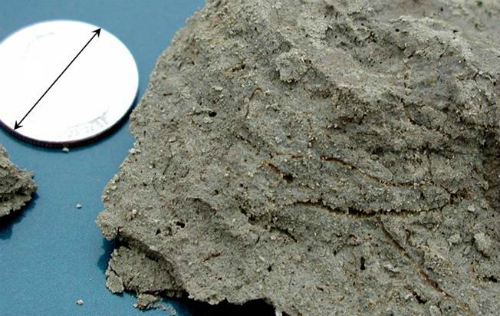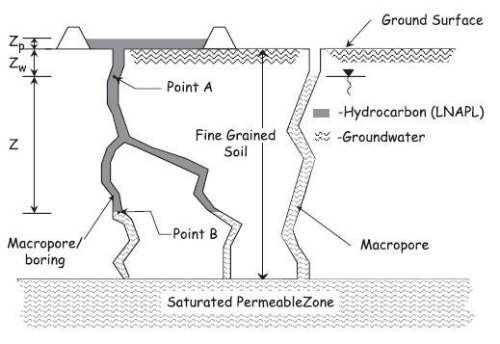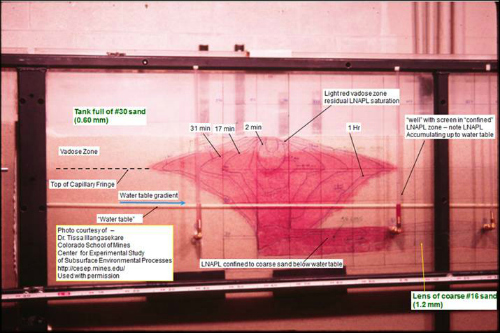Applied NAPL Science Review
Demystifying NAPL Science for the Remediation Manager
ANSR Scientific Review Board
J. Michael Hawthorne, PG, Board of Chairman, GEI Consultants Inc.
Mark Adamski, PG, BP Americas
Dr. Randall Charbeneau, University of Texas
Dr. Sanjay Garg, Shell Global Solutions (US) Inc.
Dr. Terrence Johnson, USEPA
Andrew J. Kirkman, PE, AECOM
Mark W. Malander, ExxonMobil Environmental Services
Applied NAPL Science Review (ANSR) is a scientific ejournal that provides insight into the science behind the characterization and remediation of Non-Aqueous Phase Liquids (NAPLs) using plain English. We welcome feedback, suggestions for future topics, questions, and recommended links to NAPL resources. All submittals should be sent to the editor.
Mechanisms for LNAPL to Enter
Confined Conditions
BP America
Confined Light Non-Aqueous Phase Liquid (LNAPL) seems to defy logic, and yet we know it exists. Some of the distinguishing characteristics of confined LNAPL have been discussed in multiple issues of ANSR. However, a frequently heard question is “how does the LNAPL get into confined conditions in the first place?”
Confined LNAPL is defined as LNAPL trapped under pressure in an aquifer beneath a layer with relatively lower permeability (or more accurately the higher pore entry pressure associated with the lower permeability soil) that limits the upward movement of the LNAPL.
One main property that controls migration of mobile LNAPL when water and LNAPL are both present in pore spaces is pore entry pressure. At most field sites water is normally the wetting fluid, preferentially adheres to soil, and must be displaced by LNAPL in order for the LNAPL to move into water filled pores. The pressure the LNAPL must exert to displace the water is the pore entry pressure.

Figure 1: Generalized model for LNAPL migration through porous media.
LNAPL becomes confined due to the increased pore entry pressure arising from the permeability contrast between a confining layer and the interval containing the mobile NAPL below. Once LNAPL is below a confining layer and spreads laterally, the LNAPL cannot move back up unless it has sufficient pressure to displace the water in that confining layer.
Confined LNAPL may occur in aquifers exhibiting heterogeneities regardless of whether the aquifers themselves are confined or unconfined.
Confined LNAPL in Confined Aquifers
Perhaps the more perplexing occurrence of confined LNAPL is LNAPL found confined in a high permeability layer below a low permeability layer (classic confined groundwater aquifer). Three scenarios have been proposed to explain the origin of this confined LNAPL:
- Lower Historical Water Levels
- LNAPL Hydrostatic Head in Macropore Networks
- Vertical Gradients in Macropore Networks
In each scenario, the critical step is the migration of LNAPL downward through a lower permeability zone that subsequently acts as a confining layer to the LNAPL. This migration occurs in a network of higher permeability heterogeneities referred to as a macropore network (animal burrows, root holes, fractures, connected sand lenses, un-grouted historical borings, etc.).

Figure 2: Macropore network in fine-grained soil (from Adamski et al., 2005).
1. Lower historical water levels: Confined LNAPL is commonly found in locations where the historical water level was lower than the present day water level. For example, in parts of Los Angeles County California, present day water level is 40+ feet higher than water levels observed during the mid-1900’s when the regional water level was depressed due to industrial and agricultural water production. When the water levels were low, LNAPL migrated down to the water table, then spread laterally in a higher permeability zone situated at or near the low water level. When the water level rose, the LNAPL was trapped below a lower permeability zone with a pore entry pressure higher than the LNAPL pressure.
2. LNAPL Hydrostatic Head in Macropore Networks: When LNAPL migrates in to or on to a low permeability soil layer with a macropore network and the water level is below the top of the low permeability layer the LNAPL can build up additional hydrostatic head within the macropore network. As LNAPL fills the macropore network it develops pressure greater than the water pressure and displaces water in the macropore network (see Figure 3).

Figure 3: Schematic depicting LNAPL confined to a macropore network and additional hydrostatic head resulting from LNAPL filling the macropore network above the water table. Zp is the depth of LNAPL pooling at the surface; Zw is the depth of the water table below ground surface; Z is the depth below the water table that LNAPL can penetrate in the macropore network. (from Adamski et al., 2005).
The additional LNAPL head must be balanced by increasing buoyancy of the less dense LNAPL as it penetrates beneath the water table some depth Z shown in Figure 3. If the macropore network encounters a high permeability layer with a sufficiently low pore entry pressure before the depth Z is reached then the LNAPL may enter and spread in that high permeability layer.
3. Vertical Gradients in Macropore Networks: The occurrence of substantial vertical hydraulic gradients within macropore networks in low permeability confining soil layers is common. Mercer and Cohen (1990), Adamski et al. (2005), and Charbeneau (2007) explain that LNAPL can migrate vertically down below the water level if the vertical gradient in the macropore network exceeds:
In this case the LNAPL would migrate down in the macropore network until the vertical gradient terminates in a laterally extensive layer with relatively high permeability (i.e. a confined aquifer).
Confined LNAPL in Unconfined Aquifers
LNAPL may be confined within an unconfined aquifer even though the groundwater is not (Illangasekare et al, 1995). There are two mechanisms for LNAPL to become confined in an unconfined aquifer:
1. Lower Historical Water Levels
2. LNAPL Hydrostatic Head and Lateral Migration
1. Lower Historical Water Levels: As discussed for confined aquifers, lower historical water levels may allow LNAPL to migrate down to a coarse interval overlain by a finer-grained layer in an unconfined aquifer. A subsequent increase in groundwater elevation may result in submergence and confining of LNAPL within the coarse interval (Fig. 4).
2.LNAPL Hydrostatic Head and Lateral Migration: The LNAPL head resulting from an LNAPL release may cause the LNAPL to penetrate some distance below the water table where it may access a coarse interval and migrate laterally. Figure 4 demonstrates how this process may occur.

Figure 4: Experiment with tank filled with #30 sand (0.6 mm) and one layer of #16 sand (1.2 mm) below the water level. Experiment shows how LNAPL (dyed red) entered and preferentially migrated below the water level in the coarser sand. Also shows how the LNAPL can be confined in the coarse sand interval beneath a finer sand in an unconfined aquifer.
References:
Adamski, M., Kremesec, V., Kolhatkar, R., Pearson, C., and Rowan, B. 2005. LNAPL in Fine-Grained Soils: Conceptualization of Saturation, Distribution, Recovery, and Their Modeling. Ground Water Monitoring and Remediation, 25, No.1.
Charbeneau, R.J., 2007. LNAPL Distribution and Recovery Model (LDRM) Volume 1: Distribution and Recovery of Petroleum Hydrocarbon Liquids in Porous Media. API publication 4760. API Publications, Washington, DC.
Illangasekare T.H., Armbruster III E. J., and Yates E.N., 1995. Non-aqueous phase fluids in heterogeneous aquifers – experimental study. Journal of Environmental Engineering 121 no. 8:571-579.
Mercer, J.W., and R.M. Cohen. 1990. A review of immiscible fluids in the subsurface: Properties, models, characterization and remediation. Journal of Contaminant Hydrology 6, no. 6:107–163.
Real World Limitations: A word of caution – LNAPL migration is complex and many site-specific factors are involved. It is possible, perhaps even likely, that other mechanisms for the origin of confined LNAPL exist. The proposed explanations for the origin of confined LNAPL in this article fit conditions observed at many sites, but these explanations may not fit every site.
